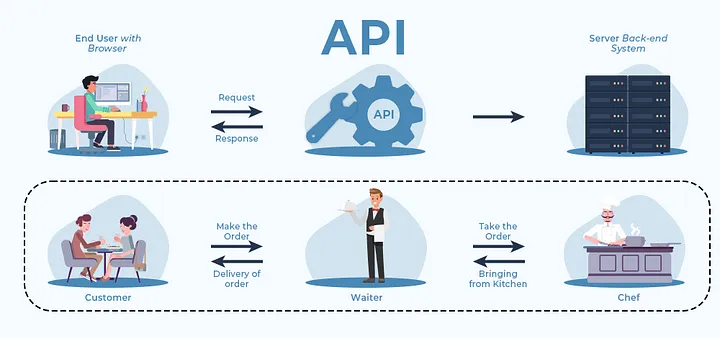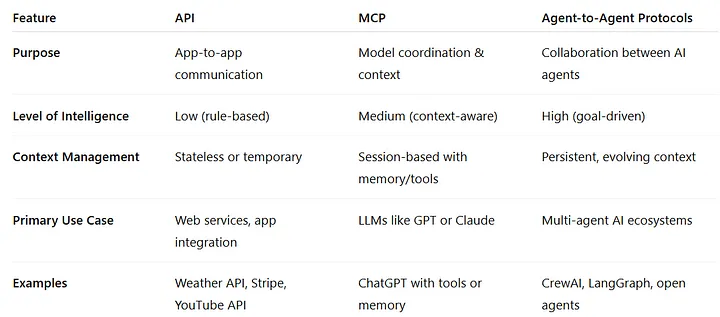API vs MCP vs Agent-to-Agent Protocols: Understanding the Building Blocks of Intelligent Systems
In today's hyper-connected digital world, communication between systems is the glue that holds modern software together. Whether you're building a mobile app, working with AI models, or exploring autonomous agents, how components talk to each other determines your system's intelligence and efficiency.
Three key ways software systems interact are through:
- 🔌 APIs (Application Programming Interfaces)
- 🧠 MCP (Model Context Protocol)
- 🤖 Agent-to-Agent Protocols
Each plays a distinct role in enabling smarter and more responsive applications. This blog breaks them down in simple terms so you know what they are, how they're different, and when to use each.
🔌 What is an API?
✅ Simple Definition
An API (Application Programming Interface) is a set of rules that allows different software programs to communicate with each other. Think of it as a menu at a restaurant: you (the user) pick what you want, and the kitchen (the server) gives it to you — without you needing to know how it's cooked.

🔧 Main Purpose
APIs let developers request specific data or functionality from another system or service. This allows apps to work together and build on each other's features — saving time and resources.
💡 Everyday Examples
- 🌤️ Weather App: Uses a weather API to get real-time forecasts
- 🔐 Instagram Login via Google: Uses an authentication API to log in users securely
- 🛒 Online Shopping: Payment gateways like Stripe or Razorpay expose APIs for secure transactions
APIs are everywhere — if two apps are working together, chances are they're connected via an API.
🧠 What is MCP (Model Context Protocol)?
✅ Definition
MCP (Model Context Protocol) is a new standard designed to help Large Language Models (LLMs) — like those from OpenAI and Anthropic — act more like intelligent agents. MCP gives models a structured way to understand and retain context, use tools, and manage memory and permissions.
🌟 What Makes MCP Unique?
Unlike APIs that pass requests and responses, MCP allows a model to:
- 🧠 Maintain memory over time (know who you are, what you asked before)
- 🛠️ Use tools or plugins (like a calculator or browser)
- 📁 Understand structured input like files, images, or settings
It transforms a language model from a one-time text generator into a context-aware assistant.
🎯 Use Cases
- 💬 Chatbots with memory: A chatbot that remembers your name, preferences, or past queries
- 🔧 Tool-using models: An LLM that calls external tools like Python or a search engine mid-response
- 📋 Session-aware assistants: Virtual agents that work with documents, apps, and ongoing tasks
MCP is the foundation for making LLMs more interactive and reliable over longer conversations or workflows.
🤖 What Are Agent-to-Agent Protocols?
✅ Definition
Agent-to-Agent Protocols govern how autonomous AI agents communicate and collaborate. These agents have their own goals, memory, and tools, and they work together to solve complex problems — often without human intervention.
This is beyond simple function calls — it's intelligent collaboration between self-directed programs.
🤝 How Agents Collaborate
- 💬 Communication: Agents pass messages or structured tasks to each other
- 📋 Delegation: One agent may divide a problem into parts and assign them to others
- ⚖️ Negotiation & Coordination: Agents adjust their actions based on what others are doing
🌍 Real-World Scenarios
- 📚 AI research teams: Agents that gather, summarize, and analyze academic papers together
- ✈️ Virtual assistants: A planning agent coordinates with a booking agent to schedule your trip
- 🎮 Multi-agent simulations: Agents in games or simulations acting with individual intelligence but shared objectives
Agent-to-agent protocols power the emerging field of multi-agent systems, which are crucial for future automation and collaborative AI.
📊 Key Differences & Comparison
Here's a side-by-side view of how APIs, MCP, and Agent-to-Agent Protocols differ:

💡 When to Use What
- 🔌 Use APIs for structured, predictable tasks like payments or data fetching
- 🧠 Use MCP when building smart assistants that require memory, tools, or personalization
- 🤖 Use Agent-to-Agent protocols when creating collaborative AI systems with autonomous behaviors
🧪 Real-World Use Cases
Here are three simple and relatable examples:
🔌 API Example
A shopping app uses a payment gateway's API to process your card without storing any financial details.
🧠 MCP Example
An AI tutor chatbot remembers your learning history, corrects previous mistakes, and suggests personalized content.
🤖 Agent-to-Agent Example
A research assistant AI splits a task — one agent gathers sources, another summarizes them, and a third compiles them into a report.
✅ Conclusion
Understanding the differences between APIs, MCP, and Agent-to-Agent Protocols gives you a powerful perspective on how modern tech systems operate.
- 🔌 APIs let systems exchange data
- 🧠 MCP gives AI models context and capability
- 🤖 Agent-to-Agent protocols enable intelligent cooperation between autonomous agents
As software evolves toward intelligent, adaptive systems, you'll encounter these protocols in cloud apps, AI tools, and automation workflows. Knowing when and why to use each helps you design smarter, more flexible tech.
🚀 The future of software isn't just about individual applications — it's about creating ecosystems where intelligent systems work together seamlessly. Whether you're building the next breakthrough app or simply trying to understand the tech landscape, these three protocols are your building blocks for tomorrow's intelligent systems.
Stay tuned to AIconic for more AI insights and updates. Follow us for the latest in AI engineering and technology trends.
